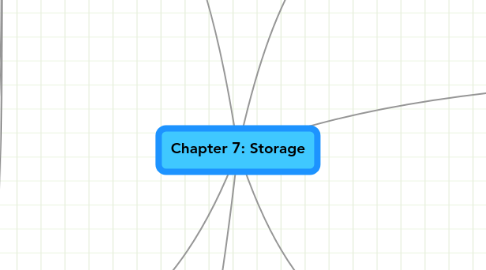
1. Hard Disks
1.1. A hard disk contains one or more inflexible, circular platters that use magnetic particles to store data, instructions, and information
1.2. Hard disks can store data using longitudinal recording or perpendicular recording
1.3. Characteristics of a hard disk include
1.3.1. Capacity
1.3.2. Platters
1.3.3. Read/Write Heads
1.3.4. Cylinders
1.3.5. Sectors and Tracks
1.3.6. Revolutions per Minute
1.3.7. Transfer Rate
1.3.8. Access Time
1.4. Formatting
1.4.1. is the process of dividing the disk into tracks and sectors so that the operating system can store and locate data and information on the disk
1.4.2. The hard disk arms move the read/write head, which reads items and writes items in the drive
1.4.2.1. Location often is referred to by its cylinder
1.4.3. A head crash occurs when a read/write head touches the surface of a platter
1.4.4. Always keep a backup of your hard disk
1.5. Raid (redundant array of independent disks)
1.5.1. is a group of two or more integrated hard disks
1.6. network attached storage (NAS)
1.6.1. device is a server connected to a network with the sole purpose of providing storage
1.7. A disk controller consists of a special‐purpose chip and electronic circuits that control the transfer of data, instructions, and information from a disk to and from the system bus and other components of the computer
1.7.1. SATA
1.7.2. EIDE
1.7.3. SCSI
1.7.4. SAS
2. Flash StoragFlash Memory Storage
2.1. Flash memory chips are a type of solid state media and contain no moving parts
2.2. Solid state drives (SSDs)
2.2.1. have several advantages over magnetic hard disk
2.2.1.1. Faster access time
2.2.1.2. Faster transfer rates
2.2.1.3. Generate less heat and consume less power
2.2.1.4. Last longer
2.3. memory card
2.3.1. A memory card is a removable flash memory device that you insert and remove from a slot in a computer, mobile device, or card reader/writer
2.4. USB flash drives
2.4.1. plug into a USB port on a computer or mobile device
2.5. ExpressCard module
2.5.1. An ExpressCard module is a removable device that fits in an ExpressCard slot
2.5.2. Developed by the PCMCIA
2.5.3. Commonly used in notebook computers
3. Other Types of StoragOther Storage
3.1. Tape is a magnetically coated ribbon of plastic capable of storing large amounts of data and information
3.2. A tape drive reads and writes data and information on a tape
3.3. A magnetic stripe card contains a magnetic stripe that stores information
3.4. A smart card stores data on a thin microprocessor embedded in the card
4. Storage
4.1. Capacity is the number of bytes a storage medium can hold
4.2. Storage device is the computer hardware that records and/or retrieves items to and from storage media
4.3. Acess time
4.3.1. measures
4.3.1.1. The amount of time it takes a storage device to locate an item on a storage medium
4.3.1.2. The time required to deliver an item from memory to the processor
5. Cloud storage
5.1. Cloud storage is an Internet service that provides storage to computer users
5.2. Users subscribe to cloud storage for a variety of reasons
5.2.1. Access files from any computer
5.2.2. Store large files instantaneously
5.2.3. Allow others to access their files
5.2.4. View time‐critical data and images immediately
5.2.5. Store offsite backups
5.2.6. Provide data center functions
6. Optical Discs
6.1. An optical disc consists of a flat, round, portable disc made of metal, plastic, and lacquer that is written and read by a laser
6.2. Typically store software, data, digital photos, movies, and music
6.3. Read only vs. rewritable
6.4. Optical discs commonly store items in a single track that spirals from the center of the disc to the edge
6.5. Track is divided into evenly sized sectors
6.6. Care of optical discs
6.6.1. CD‐ROM
6.6.1.1. can be read from but not written to • Read from a CD‐ROM drive or CD‐ROM player
6.6.2. CD‐R
6.6.2.1. is a multisession optical disc on which users can write, but not erase
6.6.3. CD‐RW
6.6.3.1. is an erasable multisession disc • Must have a CD‐RW drive
